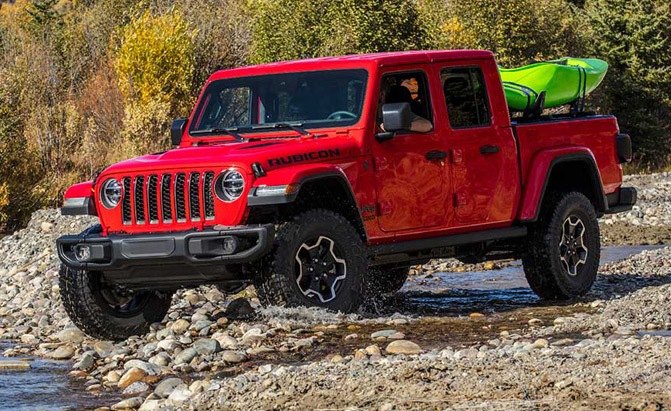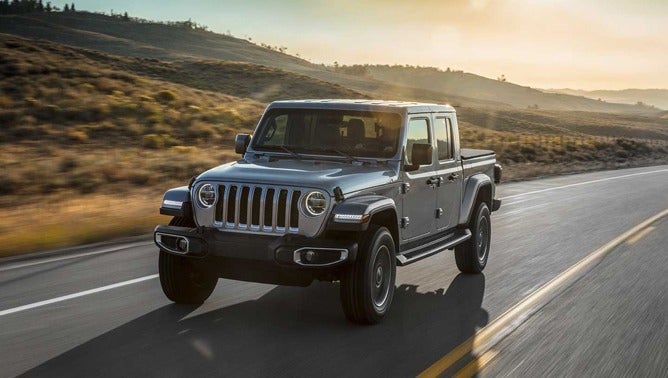The 2020 Jeep Gladiator is one of the most highly anticipated vehicles to launch in years.
It melds the off-road capability of a four-door Wrangler with the versatility of a midsize pickup truck. Now you can do some hardcore rock crawling while carrying a load of friends and all their gear. Really, this product is a no-brainer; it’s a better combination than chocolate and peanut butter.
People have been clamoring for Jeep to build a pickup ever since their last offering, the Comanche, was discontinued in 1992. Even though this legendary automotive brand has been out of the game for nearly 30 years, Gladiator is the latest in a long line of Jeep trucks reaching all the way back to the ‘40s.
More Than Just a Wrangler with a Bed
Even though this rig is essentially a Wrangler with a bed, engineers did far more than just tack weld a cargo box on the back and call it a day. In fact, the vehicle’s frame, its very foundation is all new. This critical component had to be reworked to meet the towing and hauling requirements of the midsize-truck segment.
Compared to a Wrangler Unlimited, the new Jeep Gladiator is nearly 30 inches (75.2 cm) longer, clocking in at 218 (553.7 cm) from bumper to bumper. Accordingly, the wheelbase has been stretched significantly, spanning an extra 19.4 inches (49.3 cm), totaling 137.3 (34.9 cm).
These figures mean the Gladiator lands right in the heart of the midsize-pickup segment. It’s longer than any version of the Ford Ranger offered in America, however, if equipped with their respective long-beds, a Crew Cab Chevrolet Colorado and the Double Cab Toyota Tacoma are each around seven inches longer overall.
As for the Gladiator’s all-important bed, it measures five feet and is made of steel. Of course, it’s fitted with various tie-downs but can also be equipped with a spray-in liner for maximum durability, under-rail lighting and even a three-prong power outlet.
SEE ALSO: Why the Four-Cylinder Hybrid is the Best Powertrain in a Jeep Wrangler – VIDEO
Not to be outdone, the tailgate even has a few tricks up its proverbial sleeve. Made of aluminum, it’s nicely dampened so it doesn’t slam down when opened. It supports up to 1,800 pounds (816.5 kg) on its own and can be locked in a mid-position between closed and fully open. This allows you to haul four-by-eight sheets of building material. They slide right into the bed over the wheel wells and are also supported by the tailgate.
While at the Gladiator’s rear, you’re sure to notice something missing. The Wrangler’s iconic swing gate-mounted spare tire has been relocated underneath the bed, behind the rear axle, just like on other pickups. In addition to the requisite skid plates, Rubicon models are also fitted with rock rails to protect the cab and bed from damage while trail-bashing. They can support up to one-third of the vehicle’s overall weight.
Towing and Hauling Capability
Tape-measure dimensions aside, the Gladiator also compares very favorably to its major rivals in towing and hauling capability. Properly equipped, it can carry up to 1,600 pounds and when fitted with the appropriate towing package it’s rated to drag a maximum of 7,650 pounds.
ALSO SEE: Best Jeep Gladiator Lift Kits

Checking out competing models’ capability reveals the Gladiator is at a slight disadvantage. A SuperCab four-by-two Ranger can haul up to 1,860 pounds. All versions of this Ford are rated to tow a maximum of 7,500. The Colorado tops out at 1,566 pounds of payload and can tow up to 7,700 pounds when powered by the available diesel engine. The best a Tacoma can do is 1,620 and 6,800, respectively.
Of course, this Jeep is still impressively capable, especially since it’s the only one of this bunch that comes with standard four-wheel drive. Bringing loads to a safe, secure stop, the Gladiator should also have the largest brakes in its segment.
Yep, it’s Trail Rated
When it comes to off-roading, the Gladiator is every bit as capable as the Wrangler on which it’s based. Sport, Overland and Rubicon models receive the famed Trail Rated badge, meaning they can go just about anywhere.
Ground clearance exceeds 11 inches (28.2 cm), something that helps this truck drive through up to 30 inches (76.2 cm) of water. As a visual, that comes up to approximately the bottom of the grille, which, coincidentally, has larger slots to enable better cooling for enhanced towing and payload ratings. To keep ‘em dry while fording rivers, the Gladiator’s electronics are mounted up high, plus the interior carpeting is removable should water ever sneak into the cab you can easily air it out.

Naturally, Jeep put together an off-road course for us to test this truck’s capability. The trail was muddy, strewn with jagged boulders and had plenty of elevation changes. Range-topping Rubicon models were on hand for driving here, and they proved more than up to the challenge.
Exercising this truck’s low-range gearing, disconnecting front stabilizer bar and, scarily, its front skid plate on more than a few occasions revealed there’s little the Gladiator can’t handle. From steep hills to sloppy two-tracks, off-camber corners to rocky surfaces, it’s simply amazing what a properly equipped Gladiator can tackle off road.
SEE ALSO: 2019 Ford Ranger Review – VIDEO
Two different four-wheel-drive systems are offered. Command-Trac is the base version. It features a two-speed transfer case and is offered in Sport and Overland trims. The much more capable Rock-Trac system is standard on Rubicon models. It includes locking differentials, a 4-to-1 crawl ratio and even a disconnecting front sway bar for greater suspension articulation.
Standard with the automatic transmission is Selec-Speed Control, which is like cruise control for off-road driving. It can be engaged when the transfer case is in low range. Uphill or down, it enables the vehicle to manage its own speed, which can be set anywhere between 1 and 5 miles an hour.

If there’s a downside to trail-bashing in this truck, it’s length, the very thing that makes it so versatile. Given that it’s much longer than even a four-door Wrangler Unlimited, the Gladiator could be more challenging to maneuver in tight off-road situations.
Still, in the dirt, this is almost certainly the most capable midsize pickup available, though Colorado ZR2 Bison might give it a run for its money. Ditto for the Ranger Raptor, should Ford ever decide to sell it in North America.
On-Road Refinement
Like the Wrangler JL, Gladiator is unexpectedly refined on road. At least in Overland trim, the version tested on road here, is quiet and spacious, plus it feels like Jeep designers put tons of thought and energy into crafting the interior. All the hard plastics are upscale, there’s plenty of soft stuff and even the screws around the climate controls are real.

The Gladiator also offers best-in-class rear-seat legroom so everyone can ride in comfort. For added versatility, there’s secure storage behind the seat backs, which also fold flat. Beyond that, the seat cushions flip up revealing another generously sized storage area.
One nice touch is the so-called “bolt bin,” a storage cubby for all the stray fasteners when you take doors off or fold the windshield down. The lid even has special graphics showing you where each piece goes on the vehicle, a clever addition.

Two engines will be offered in the Gladiator, along with a pair of transmissions. The standard powerplant is a friendly and familiar 3.6-liter Pentastar V6. Smooth running and snarly under heavy throttle, it’s rated at 285 horses and 260 pound-feet of torque.
At some point in 2020 (it’s unclear if that will be model year or calendar year), a 3.0-liter EcoDiesel V6 will join the range. It’s expected to deliver 260 ponies with 442 pound-feet. It will come bolted exclusively to an eight-speed automatic transmission. For drivers that can handle three pedals, a six-speed manual gearbox is also offered with the gasoline engine.

Undoubtedly, thanks to that efficient automatic transmission the Pentastar V6 provides rapid acceleration. This drivetrain is refined and willing, changing gears smoothly and downshifting readily; it’s also reasonably efficient. Expect 17 miles per gallon city, 22 highway and 19 combined. Opt for the manual and you should get 16, 23 and 19, respectively. These figures are very comparable to six-cylinder versions of the Colorado and Tacoma, though they’re a little less than what the EPA says a four-by-four Ranger should deliver. They sticker at 20 city, 24 highway and 22 combined, though whether they’re that economical in real-world driving is questionable.
SEE ALSO: 2019 Chevrolet Colorado Bison Review
If there’s any weakness to the Gladiator’s on-road performance, it’s likely ride quality. Yes, it’s remarkably refined considering the outrageous capability, and the fact that it has live axles front and rear, but it still bounces and jiggles a bit on irregular pavement. This is a bit surprising considering it shares a number of rear-suspension components with the Ram 1500, the best-riding full-size truck available today.
You’d think the Gladiator would feel noticeably smoother than the Wrangler, courtesy of its elongated wheelbase, but it’s difficult to say for certain without driving them back to back.
The Verdict: 2020 Jeep Gladiator Review
You can call the Gladiator a midsize pickup, but it’s kind of in a segment all its own. In everyday use, it is less refined and comfortable than a Colorado or Ranger, but it does things neither of those rivals can. If you want a smaller truck with on-road civility or mountain-goat capability you’ve now got a choice.

A base Sport model starts at $35,040 while the Sport S version goes for $38,240. Opt for the Overland trim and plan on spending $41,890. A top-of-the-line Rubicon version kicks off at $44,949. All these prices include $1,495 in delivery fees. Look for the 2020 Jeep Gladiator at dealerships in May, or find out how to buy the new Launch Edition model for one day only here.
ALSO SEE: Jeep Renegade vs Compass: Which Jeep is Right for You?
Discuss this story on our Jeep Gladiator Forum
This article originally appeared on AutoGuide.com

 Your Privacy Choices
Your Privacy Choices